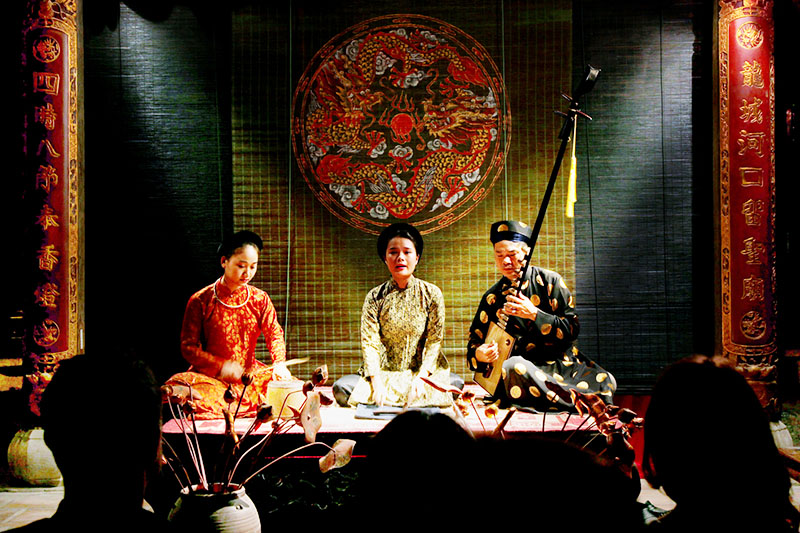Folk music is far more diverse in its styles since it can vary from region to region. A few of these artforms include Cheo (a type of satirical musical theatre performed by peasants), Quan ho (a type of improvised singing used in courting rituals), Nhac dan toc cai bien (a type of modern folk song developed in the 1950s and criticized by purists), Cai luong (a type of theatre popular during the French colonial days), Xam (a dying northern regional folk music commonly performed by blind musicians), Hat chau van (rhythmic type of music used to call spirits and put people in a trance), and Ca tru (a type of folk song sung mainly by women as an almost geisha-like entertainment).
Vietnam borrowed many of their instruments from China and other areas in Asia. They use a variety of stringed instruments like fiddles (dan gao, dan nhi, dan k’ni), lutes (dan nguyet, dan sen, dan tam, dan ty ba), and zithers and dulcimers (dan bau, dan tam thap luc, dan tranh). There are also a number of percussion instruments like different sizes of drums as well as a type of bamboo xylophone called the t’rung. A few woodwinds are played that include different kinds of flutes and an oboe called a ken bau.
 |
| Woman playing the dan bau. |
Dance is highly integrated with music and theatre. Many of their dances are related to several similar Chinese dances. Some of these theatrical dances include the cai luong, hat tuong, and the hat cheo. Other dances were performed in the court and others at ceremonies, festivals, and family or community events. One such dance is the Lion Dance, which is often performed at the Lunar New Year (Tet) and the Mid-Autumn Festival (Tet Trung Thu). It must be a sight to see because it’s usually followed by acrobatics and showcases of martial arts.
I found quite a few Vietnamese musicians on Spotify, many of them being pop musicians. The first one I listened to was Ho Quynh Huong. It was on the slower side of pop, seemingly more mellow and emotional. I next listened to My Tam. One song was a little more upbeat, but the rest of the album was also slower and more introspective. Another musician who put out a whole album of love songs is Ho Ngac Ha. Using very much of a synthesized sound, I also listened to some songs by Lam Truong. Although some songs were slower, there were a few more upbeat songs. It has a very retro sound to it.
 |
| Son Tung M-TP |
In a shift to a more modern style of pop, I checked out Son Tung M-TP. He uses some sound effects and some electronica beats behind some of the songs. Bau Thy does have some songs that seemed upbeat and catchy, some with acoustic guitar, but there were also a lot of slower songs mixed in. Slow songs must really be a favored style in Vietnamese music. I thought that the two pop musicians Thuy Chi and Khong Tu Quynh both fall in this category as well: modern, utilizing some Western styles at times, but still mixes these songs in between slower, more traditional sounding pop songs.
| Buc Tuong |
I also listened to a couple rock bands. The first one was Buc Tuong. They have a very strong alternative rock sound. I kinda liked what I heard. Some songs were harder than others, which I liked. Ngu Cung was the other rock band I listened to. They were definitely more metal, so you know I really liked them. But they’re also not afraid of dropping it back and getting soft and melodic in the middle either. I enjoyed what I heard quite a bit.
And lastly, I didn’t find many, but I did come across one hip-hop artist who I sampled. This artist is also known as the Vietnamese rap queen: Suboi. She’s known for her song "Doi," which was pretty catchy. I have no idea what she’s rapping about, but it was interesting to listen to her songs. I believe this is the first time I’ve ever heard rap in Vietnamese.
Up next the food




No comments:
Post a Comment